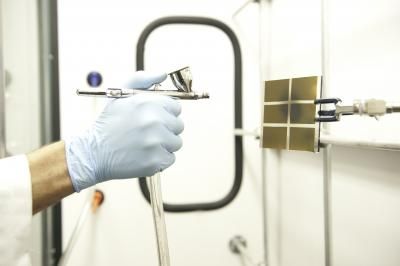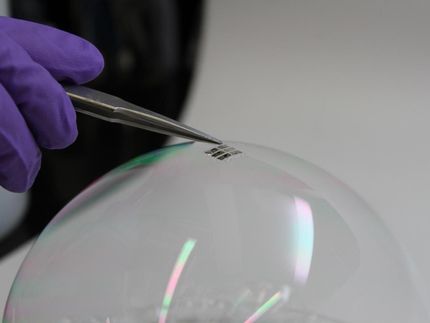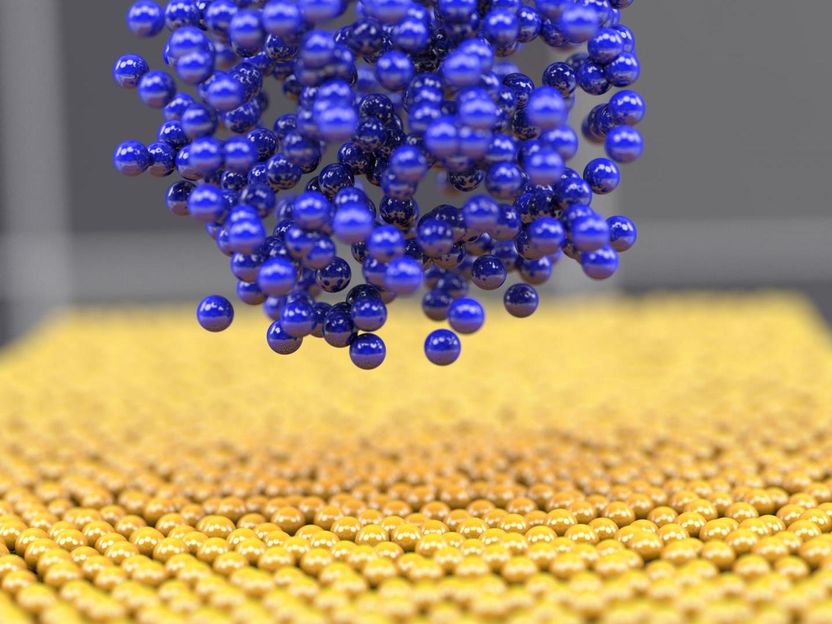Lower-cost solar cells to be printed like newspaper, painted on rooftops
solar cells could soon be produced more cheaply using nanoparticle "inks" that allow them to be printed like newspaper or painted onto the sides of buildings or rooftops to absorb electricity-producing sunlight.

Researchers apply the nanoparticle "inks" as a spray on the solar cells.
Beverly Barrett, UT Engineering Public Affairs
Brian Korgel, a University of Texas at Austin chemical engineer, is hoping to cut costs to one-tenth of their current price by replacing the standard manufacturing process for solar cells – gas-phase deposition in a vacuum chamber, which requires high temperatures and is relatively expensive.
"That's essentially what's needed to make solar-cell technology and photovoltaics widely adopted," Korgel said. "The sun provides a nearly unlimited energy resource, but existing solar energy harvesting technologies are prohibitively expensive and cannot compete with fossil fuels."
For the past two years, Korgel and his team have been working on this low-cost, nanomaterials solution to photovoltaics – or solar cell – manufacturing. Korgel is collaborating with professors Al Bard and Paul Barbara, both of the Department of Chemistry and Biochemistry, and Professor Ananth Dodabalapur of the Electrical and Computer Engineering Department. They recently showed proof-of-concept in an issue of Journal of the American Chemical Society.
The inks could be printed on a roll-to-roll printing process on a plastic substrate or stainless steel. And the prospect of being able to paint the "inks" onto a rooftop or building is not far-fetched.
"You'd have to paint the light-absorbing material and a few other layers as well," Korgel said. "This is one step in the direction towards paintable solar cells."
Korgel uses the light-absorbing nanomaterials, which are 10,000 times thinner than a strand of hair, because their microscopic size allows for new physical properties that can help enable higher-efficiency devices.
In 2002, he co-founded a company called Innovalight, based in California, which is producing inks using silicon as the basis. This time, Korgel and his team are using copper indium gallium selenide or CIGS, which is both cheaper and benign in terms of environmental impact.
"CIGS has some potential advantages over silicon," Korgel said. "It's a direct band gap semiconductor, which means that you need much less material to make a solar cell, and that's one of the biggest potential advantages."
His team has developed solar-cell prototypes with efficiencies at one percent; however, they need to be about 10 percent.
"If we get to 10 percent, then there's real potential for commercialization," Korgel said. "If it works, I think you could see it being used in three to five years."
He also said that the inks, which are semi-transparent, could help realize the prospect of having windows that double as solar cells. Korgel said his work has attracted the interest of industrial partners.
Most read news
Topics
Organizations
Other news from the department science

Get the chemical industry in your inbox
By submitting this form you agree that LUMITOS AG will send you the newsletter(s) selected above by email. Your data will not be passed on to third parties. Your data will be stored and processed in accordance with our data protection regulations. LUMITOS may contact you by email for the purpose of advertising or market and opinion surveys. You can revoke your consent at any time without giving reasons to LUMITOS AG, Ernst-Augustin-Str. 2, 12489 Berlin, Germany or by e-mail at revoke@lumitos.com with effect for the future. In addition, each email contains a link to unsubscribe from the corresponding newsletter.






























































